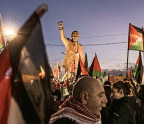The WATSON FILES
JUST after sunrise on April 1, 2008, the renowned English ecologist Murray Watson left the Saakow Hotel, a modest concrete guesthouse in rural southern Somalia, heading off for work in a Nissan Patrol. He and a Kenyan colleague, an engineer named Patrick Amukhuma, along with a translator and two guards, were on their way to finish up a survey of flood-prone areas for the United Nations using an aerial and ground survey technique Watson had pioneered decades earlier.
One of the more lush regions in a largely arid country, the area covered by Watson’s survey was also among the most hazardous. It was crawling with al-Shabab extremists, who had taken to extorting the banana and sugarcane farms that unfurled along the banks of the Shabelle and Jubba rivers. Increasingly erratic rainfall, a phenomenon scientists have linked to climate change, was further threatening the farms by causing frequent floods that Watson hoped his survey could help mitigate. Though the 69-year-old Englishman wouldn’t have described it as such, he was leading a groundbreaking climate adaptation effort in a country that is among the most vulnerable to climate change—and to the conflict that often follows in its wake.
Watson knew the dangers of working in this region, but over the years he had honed a set of instincts that usually kept him out of harm’s way. He had lived in Somalia on and off for more than a decade (from the late 1970s until the government collapsed in 1991), spoke basic Somali, and was married to a Somali-Kenyan woman. He was fluent in the country’s ever-shifting power dynamics. But no amount of local knowledge could have saved him that spring morning.
About an hour after they left the hotel, as they bumped along a dirt road that ran parallel to the Jubba River, Watson and Amukhuma came upon a vehicle blocking their path. Six gunmen lay in wait. The driver attempted an evasive U-turn but got stuck in a gully as the attackers opened fire. Watson was hit, and blood soaked through the sleeve of his shirt. One of the guards surrendered his weapon; the other fled on foot after firing a few rounds. The gunmen tied up the driver and translator, leaving them behind. Then they pushed Watson and Amukhuma into the car and sped off deeper into the wilderness.
One of the guards managed to call the Saakow Hotel and a band of local militia quickly mobilized to search for the researchers. When they got to the scene of the ambush, they found Watson’s driver, the translator, and the guards. The kidnappers and their victims were long gone.
For days, authorities from Britain’s embassy in neighboring Kenya worked to track them down. So did a number of Watson’s friends and acquaintances, including the veteran BBC reporter Owen Bennett-Jones, who was based in London but had contacts at the BBC Somali Service. The Brits sent at least two search parties to case the area around Jilib—a town where they believed he
You’re reading a preview, subscribe to read more.
Start your free 30 days





